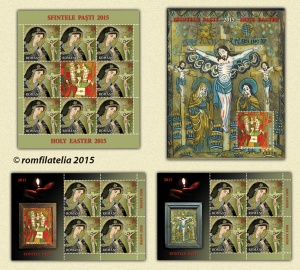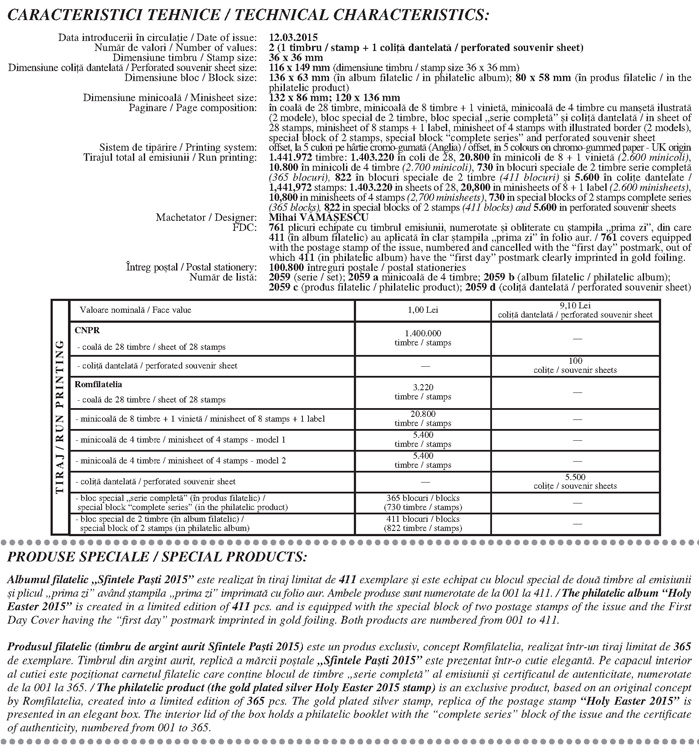 Therefore we have been buried with him by baptism into death, so that, just as Christ was raised from the dead by the glory of the Father, so we too might walk in newness of life; (Romans 6:4)
Therefore we have been buried with him by baptism into death, so that, just as Christ was raised from the dead by the glory of the Father, so we too might walk in newness of life; (Romans 6:4)
After a long preparation – the forty day fast when Christians crucify themselves along with Christ, mortifying their bodies through asceticism and prayer – the Easter Holiday is experienced as a celebration of the passage from death to life. This is the true meaning of the term Holy Easter, which in the Greek language means a passage from the earthly to the heavenly.
As a pilgrim on earth through this valley of tears, humanity seeks the deeper sustenance of the spiritual life, stemming from our impulse to discover, in atruer way, the presence of God. Within the family, in the parental house and in church, the Christian strives to find themselves, to meet Christ again and to relive the mystery of the communion with God and the fellow man, by receiving and offering forgiveness.
This year, Romfilatelia invites you to stop at Nicula, in the Ardeal region in the heart of Transylvania, to visit one of the oldest monastic settlements and an important centre of spirituality and culture, known both for its pilgrimages to the Miracle-Working Icon, and for the painting of icons on glass.
Around this foremost Christian holiday, Romfilatelia dedicates a postage stamp issue, Holy Easter 2015, to the remembrance of two very important moments in Jesus Christs life: the Crucifixion and the Resurrection.
The stamp with the face value of lei 1.00 illustrates Christs sacrifice, namely the iconographic image of the Weeping Mother, in a manner specific to the Lancram painting centre in Sebes county. This icon dates back to the mid-nineteenth century and is currently found at the Nicula Monastery.
The Weeping Mother translates into visual language the Righteous Simeons prophecy: The sword will pass through your soul. The tragedy of Jesus Crucifixion is amplified by His Mothers pain and sadness, admirably expressed by the somber black-grey colours of a muted register. The chromatic scarcity is pushed to extremes, the two nuances being joined by the green of the garment, the pink of skin and some red accents that render prominently the Virgins lips and the blood of Jesus.
The picture is simply organized around the face, not delimited from the neck, and the clasped hands, held together in prayer. There can be seen, on the black Veil, the Virgins three stars. The decorative element is minimized; the crossseems to be floating and from Jesus Christs hands, streams of blood are flowing. The inscriptions are written neatly, while the drawing is carefully done.
The Crucifixion icon reproduced on the border of the souvenir sheet belongs to the Lancram-Sebes paining centre and dates back to the middle of the nineteenth century. Today it is held in the collection of the Nicula Monastery.
The crucifixion is the moment of the supreme exaltation of humanity – a sacrifice or perfect giving of Gods selfhood to the Father in perfect obedience … obedient unto death, even death on a cross… and perfect descent of God onto His creation … a crucified God who takes the form of a servant, and being made the same as us, is not hindered by the nails in His hands to embrace the whole of human being – Father forgive them… not just this sin but all their sins … all those who believe and worship in the spirit of the Son- the Crucified.
The cross of the Saviour’s Crucifixion is placed in the center of the composition, symmetrically framed by the Virgin Mary and St. John the Evangelist, sitting at the foot of the cross, and the background is bordered by the crosses of the two thieves crucified with him. Here too, the extreme simplification of colour emphasizes the dramatic contrast between the pale pink flesh and the cold background. The sun and moon, as symbols of day and night, refer to the visible world, horrified by the death of its Creator.
On the stamp of the souvenir sheet, with the face value of lei 9.10, is reproduced the icon of the Resurrection of Jesus, painted in the Nicula centre, in the first half of the 19th century and belonging to the Transylvanian Museum of Ethnography. The Saviour, victoriously exiting the grave, bears the banner of the Resurrection in his left hand. Two soldiers, overwhelmed, point to Christ with awe. Barefoot, wrapped in a green scarf, Christ walks on the grave slab and gives His blessing with His right hand. He is framed by two vertical rows of white clouds symbolizing the divine glory. The seals of the tomb remained unopened – a brilliant compositional solution by the peasant artist which is in full agreement with the text of the Bible, a fact which accentuates the secret character of the moment. The holy day of Easter has been and will remain the greatest, the Holy Christian holiday, as well as the greatest holiday of the human soul. On Easter, the liturgical celebrations are totally special. The beauty of the songs, the priests bright robes, the crowded churches filled with believers that carry candles, all of these express the joy and light of those who announce and witness: Christ is risen! Truly He is risen!
Romfilatelia thanks His Grace Andrei Andreicut, Archbishop of Vad, Feleac and Cluj and Metropolitan of Cluj, Maramures and Salaj, Archimandrite Nicolae Moldovan, abbot of Nicula Monastery, Cluj county, Mr. Tudor – Alexandru Salagean, manager of the Transylvanian Museum of Ethnography andMr. Ioan Teglas, photographer, for their support in the achievement of this postage stamp issue.
Also, Romfilatelia thanks Father Siluan Timbus for the documented text offered for the materialization of this philatelic project.
As a pilgrim on earth through this valley of tears, humanity seeks the deeper sustenance of the spiritual life, stemming from our impulse to discover, in atruer way, the presence of God. Within the family, in the parental house and in church, the Christian strives to find themselves, to meet Christ again and to relive the mystery of the communion with God and the fellow man, by receiving and offering forgiveness.
This year, Romfilatelia invites you to stop at Nicula, in the Ardeal region in the heart of Transylvania, to visit one of the oldest monastic settlements and an important centre of spirituality and culture, known both for its pilgrimages to the Miracle-Working Icon, and for the painting of icons on glass.
Around this foremost Christian holiday, Romfilatelia dedicates a postage stamp issue, Holy Easter 2015, to the remembrance of two very important moments in Jesus Christs life: the Crucifixion and the Resurrection.
The stamp with the face value of lei 1.00 illustrates Christs sacrifice, namely the iconographic image of the Weeping Mother, in a manner specific to the Lancram painting centre in Sebes county. This icon dates back to the mid-nineteenth century and is currently found at the Nicula Monastery.
The Weeping Mother translates into visual language the Righteous Simeons prophecy: The sword will pass through your soul. The tragedy of Jesus Crucifixion is amplified by His Mothers pain and sadness, admirably expressed by the somber black-grey colours of a muted register. The chromatic scarcity is pushed to extremes, the two nuances being joined by the green of the garment, the pink of skin and some red accents that render prominently the Virgins lips and the blood of Jesus.
The picture is simply organized around the face, not delimited from the neck, and the clasped hands, held together in prayer. There can be seen, on the black Veil, the Virgins three stars. The decorative element is minimized; the crossseems to be floating and from Jesus Christs hands, streams of blood are flowing. The inscriptions are written neatly, while the drawing is carefully done.
The Crucifixion icon reproduced on the border of the souvenir sheet belongs to the Lancram-Sebes paining centre and dates back to the middle of the nineteenth century. Today it is held in the collection of the Nicula Monastery.
The crucifixion is the moment of the supreme exaltation of humanity – a sacrifice or perfect giving of Gods selfhood to the Father in perfect obedience … obedient unto death, even death on a cross… and perfect descent of God onto His creation … a crucified God who takes the form of a servant, and being made the same as us, is not hindered by the nails in His hands to embrace the whole of human being – Father forgive them… not just this sin but all their sins … all those who believe and worship in the spirit of the Son- the Crucified.
The cross of the Saviour’s Crucifixion is placed in the center of the composition, symmetrically framed by the Virgin Mary and St. John the Evangelist, sitting at the foot of the cross, and the background is bordered by the crosses of the two thieves crucified with him. Here too, the extreme simplification of colour emphasizes the dramatic contrast between the pale pink flesh and the cold background. The sun and moon, as symbols of day and night, refer to the visible world, horrified by the death of its Creator.
On the stamp of the souvenir sheet, with the face value of lei 9.10, is reproduced the icon of the Resurrection of Jesus, painted in the Nicula centre, in the first half of the 19th century and belonging to the Transylvanian Museum of Ethnography. The Saviour, victoriously exiting the grave, bears the banner of the Resurrection in his left hand. Two soldiers, overwhelmed, point to Christ with awe. Barefoot, wrapped in a green scarf, Christ walks on the grave slab and gives His blessing with His right hand. He is framed by two vertical rows of white clouds symbolizing the divine glory. The seals of the tomb remained unopened – a brilliant compositional solution by the peasant artist which is in full agreement with the text of the Bible, a fact which accentuates the secret character of the moment. The holy day of Easter has been and will remain the greatest, the Holy Christian holiday, as well as the greatest holiday of the human soul. On Easter, the liturgical celebrations are totally special. The beauty of the songs, the priests bright robes, the crowded churches filled with believers that carry candles, all of these express the joy and light of those who announce and witness: Christ is risen! Truly He is risen!
Romfilatelia thanks His Grace Andrei Andreicut, Archbishop of Vad, Feleac and Cluj and Metropolitan of Cluj, Maramures and Salaj, Archimandrite Nicolae Moldovan, abbot of Nicula Monastery, Cluj county, Mr. Tudor – Alexandru Salagean, manager of the Transylvanian Museum of Ethnography andMr. Ioan Teglas, photographer, for their support in the achievement of this postage stamp issue.
Also, Romfilatelia thanks Father Siluan Timbus for the documented text offered for the materialization of this philatelic project.
Issue date: 2015-03-12



